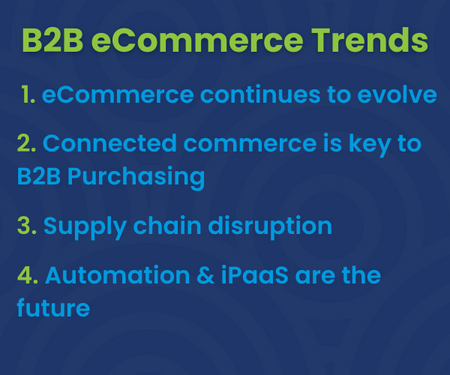Table of Contents
Gartner estimates that 80% of B2B sales interactions between buyers and suppliers will occur digitally within the next three years. As B2B eCommerce trends evolve, digitization in commerce will only accelerate.
The primary goal throughout our company’s history has been (and will continue to be) to streamline and automate trade between buyers and suppliers. What began with a goal to revolutionize the PunchOut process has since expanded into a broad scope of connected commerce solutions that solve a variety of challenges within the B2B buying and selling process.
TradeCentric maintains a close pulse on B2B eCommerce trends to ensure our roadmap is harmonious with the industry’s evolution. As the digital commerce space continues to evolve, so will our solutions.
Here are the top B2B eCommerce emerging trends that will impact B2B trade and TradeCentric’s technology investment moving forward.
B2B eCommerce is Booming for New and Existing Customers

Unsurprisingly, the vast majority of purchasing has moved online – and that includes business purchasing.
McKinsey & Company reports that B2B eCommerce digital channels surpassed in-person sales in 2021, with 65% of customers opting for online channels. Last year was also the first year B2B suppliers were more likely to offer eCommerce than in-person sales.
As purchasing shifts to an online format, leading businesses are investing in enhancing their B2B eCommerce capabilities. In fact, a third of businesses rank eCommerce as the single most effective of all digital channels, putting it well ahead of traditional in-person sales for their business buyers.
Analysts expect B2B eCommerce growth to continue in 2023, with a compound annual growth rate of 18.7% between 2021 and 2028. Businesses that have not yet transitioned to B2B eCommerce and take a reactive versus proactive approach run the risk of losing customer loyalty by providing a sub-optimal shopping experience. Not only does this hurt competitive advantage, but it also hinders a company’s ability to position themselves as innovators in the market.
Offering an B2B eCommerce storefront is only one piece of the puzzle. Strategic suppliers are adapting to customers’ preferences to purchase via eProcurement solutions. They recognize that meeting the demand for integration could be what differentiates their business from competitors. Establishing customer loyalty and creating a self-service purchasing experience via an eCommerce store can make the difference in meeting and exceeding existing customers’ expectations.
Not only does integration enable more online sales by providing real-time inventory management and pricing, but it also helps maintain a competitive edge by better meeting customer expectations. Buyers are more willing to purchase from a company that can automate the procurement process and with solutions to easily integrate into their existing systems in ways that third-party online marketplaces cannot.
Simply put, if keeping pace with B2B eCommerce trends and offering integration aren’t part of your existing sales strategy, you risk being left behind when customers choose competitors that offer a superior, self-service customer experience.
Connected Commerce is Key to B2B Purchasing Strategy
B2B Connected commerce solutions such as PunchOut and Purchase Order Automation facilitate and streamline the flow of data and transactions between eCommerce systems and eProcurement solutions.
Sales conducted via eProcurement increased nearly 20% last year, from $798.4 billion to $934.2 billion. There is limitless opportunity in digital purchasing, with eProcurement sales topping $1 trillion in 2022 and global spending on eProcurement order management software exceeding $1 billion.
The primary goal of eProcurement platforms such as Coupa, Jaggaer, SAP, and many others is to help buyers streamline and create more efficient fulfillment processes. But another key advantage of eProcurement solutions is their ability to connect with B2B eCommerce systems and purchase products all in one place.
Nearly three-fourths of B2B eCommerce organizations use automation technologies to streamline business processes, and eCommerce-based automation helps procurement run faster and more efficiently. With this type of customer experience, inventory management has never been easier, customer acquisition has never been more efficient, and a new way to reduce supply chain complexity has been introduced into the buyer journey.
B2B eCommerce integration and automation offer many benefits: buyers can access approved suppliers directly within their eProcurement solution, two-way data transfer is handled automatically and error-prone manual data entry is no longer necessary.
The advantage to suppliers is this: a better, more streamlined purchasing experience for customers translates to higher volume and more frequent sales. Suppliers should explore ways to integrate their eCommerce system with their customers’ eProcurement solutions to ramp up eCommerce sales and create seamless transactions that drive efficiency for all.
Supply Chain Disruption Will Continue
Global supply chains have experienced unprecedented and unpredictable volatility over the last three years. Existing challenges with supply chains were compounded by the global pandemic, and businesses have been hit with wave after wave of ongoing disruptions, significantly affecting shopping and digital self-service.
According to the Hubs Supply Chain Resilience Report 2021, 75% of businesses experienced external disruptions to their manufacturing supply chain and 56% experienced more disruption than in the previous year.
Unfortunately, this will be among the B2B eCommerce trends to continue. Experts predict supply chain turmoil will continue throughout the year, forcing companies and consumers alike to accept a new normal in the online marketplace.
While COVID-19 may have created many of the supply chain challenges businesses face today, the pandemic isn’t the only cause of supply chain disruption. There are ongoing parts shortages as a result of regional shutdowns and an influx of order volumes. One example is the global chip shortage, which impacts nearly every industry from electronics to auto manufacturing and industrial machinery. Along with inventory scarcity, businesses are experiencing significant shipping delays on top of rising transportation costs.
In the face of ongoing disruptions, buyers must quickly identify ways to diversify and mitigate risk within the supply chain. Technology such as connected commerce allows buyers to quickly onboard new suppliers to have more access to products needed.
Businesses with the ability to integrate are more likely to make the vendor selection shortlist when buyers or marketplace operators are looking to onboard and connect with new suppliers quickly. Buyers are keen to compare solutions and choose eCommerce platforms that provide personalized shopping experiences, even from mobile devices.
API-Driven Automation & iPaaS-based B2B eCommerce Solutions Are the Future
In the past, procurement automation was limited to static Catalog Interchange Format (CIF) files or complex CDI catalogs. These older technologies are too simplistic and unreliable to provide the rich self-service experience that is part of many customer expectations.
Modern B2B eCommerce environments leverage API-driven integration and automation to provide reliable, responsive, up-to-date purchasing data. At the same time, the adoption of purpose-built B2B Integration Platform-as-a-Service (iPaaS) is growing rapidly as companies seek a link between B2B eCommerce systems and customer eProcurement solutions.
B2B iPaaS transparently handles two-way communication between a supplier and their customer, allowing sellers to offer procure-to-pay automation without the cost and hassle of custom integration projects and ongoing technical support.
In 2020, iPaaS solutions generated $3.74 billion in revenue on the back of a year-on-year growth rate of 38.7%. The growth doesn’t stop there, with Gartner predicting the iPaaS market will exceed $9 billion by 2025.
As B2B transactions become increasingly digital, automation is among the B2B eCommerce trends that are necessary to keep pace with the flow between buyers and suppliers. By automating and integrating B2B eCommerce transactions – including purchase orders, invoices, requests for quotes, order acknowledgment, advanced shipping notifications, and PunchOut solutions – buyers and suppliers can more quickly and reliably connect to more trading partners while providing a more modern customer experience.
Setting Our Sights on B2B eCommerce Trends in the Future
TradeCentric occupies a unique position in the market. Central to the buyer/supplier trading process, this “trade-centric” positioning has been a cornerstone of business development over the years. For this reason, it is necessary to have a brand name that reflects the full scope of the position within the market.
The TradeCentric name reflects a deep connection to the buyer and supplier community, and a promise to continue delivering on the commitments made to clients for the last decade: enabling a modern, seamless, streamlined trading experience.
Reach out to TradeCentric today to get started on taking your eProcurement or B2B eCommerce experience to the next level.
Sincerely,
Troy Lynch, CEO





